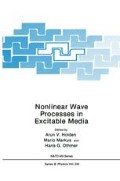Abstract
We have analyzed the spatial pattern formation of macroconidia in Neurospora crassa (bd-strain). Macroconidia are the vegetative spores produced during vegetative growth of a mycelium as shown in Fig. 1. A fungal mycelium is initiated by a spore (or a small portion of mycelium) in the centre of a nutrient agar plate. Hyphae grow and branch in radial directions from this centre (Fig. 2). They can differentiate into aerial hyphae which give rise to spores (macroconidia). The well known concentric ring pattern of spore distribution is due to an internal clock mechanism (circadian rhythm) controlling spore differentiation (see [5, 6] for review). Various facts support the hypothesis that each hyphal filament contains an internal clock. Thus the fungal mycelium may represent an ensemble of coupled or noncoupled oscillators[2, 14].
Access this chapter
Tax calculation will be finalised at checkout
Purchases are for personal use only
Preview
Unable to display preview. Download preview PDF.
References
Bourret, R.A., Lincoln, R.G. & Carpenter, B.B. (1969). Fungal endogenous rhythms expressed by spiral figures. Science 166, 763.
Dharmananda, S. & Feldman, J.F. (1979). Spatial distribution of circadian rhythm in aging cultures of Neurospora Crassa. Plant Physiol. 63, 1049.
Dienes, L. (1946). Reproductive processes in Proteus cultures. Proc. Soc. exp. Biol. N.Y. 63, 265.
Dienes, L. (1947). Further observations on the reproduction of bacilli from large bodies in Proteus cultures. Proc. Soc. exp. Biol. N.Y. 66, 97.
Edmunds, L.N. (1988). Cellular and molecular bases of biological clocks. Springer: New York, Berlin, Heidelberg.
Feldman, J.F. & Dunlap, J.C. (1983). Neurospora Crassa: A unique system for studying circadian rhythms. Photochem. Photobiol. Rev. 7, 319.
Horowitz, N.H. (1947). Methionine synthesis in Neurospora. JBC, 255.
Neumann, J.v. (1966). Theory of self-reproducing automata University of Illinois Press.
Smith, D.G. (1972). The Proteus swarming phenomenon. Sc. Prog. (Oxford) 60, 487.
Vogel, H.J. (1964). Distribution of lysine pathways among fungi: evolutionary implications. Amer. Naturalist 98, 430.
Winfree, A.T. (1970). The oscillatory control of cell differentiation in Nectria. Proc. IEEE Symp. on Adaptive Processes XXIII, 4.1–4.7.
Winfree, A.T. (1973). Polymorphic pattern formation in the fungus Nectria. J. Theor. Biol. 38, 363.
Winfree, A.T. (1980). The geometry of biological time. Springer: New York, Berlin, Heidelberg.
Winfree, A.T. & Twaddle, G.M. (1981). The Neurospora mycelium as a two-dimensional continuum of coupled circadian clocks. In Mathematical Biology, Burton, T.A. (ed.). Pergamon Press.
Author information
Authors and Affiliations
Editor information
Editors and Affiliations
Rights and permissions
Copyright information
© 1991 Springer Science+Business Media New York
About this chapter
Cite this chapter
Deutsch, A., Rensing, L., Dress, A. (1991). Patterns of Spore Formation in Neurospora Crassa and Their Simulation With a Cellular Automaton. In: Holden, A.V., Markus, M., Othmer, H.G. (eds) Nonlinear Wave Processes in Excitable Media. NATO ASI Series, vol 244. Springer, Boston, MA. https://doi.org/10.1007/978-1-4899-3683-7_24
Download citation
DOI: https://doi.org/10.1007/978-1-4899-3683-7_24
Publisher Name: Springer, Boston, MA
Print ISBN: 978-1-4899-3685-1
Online ISBN: 978-1-4899-3683-7
eBook Packages: Springer Book Archive

